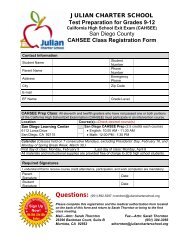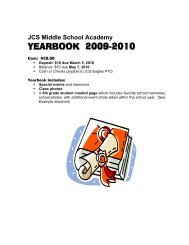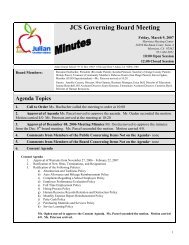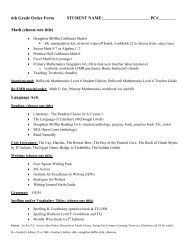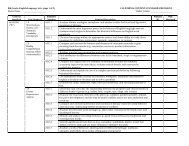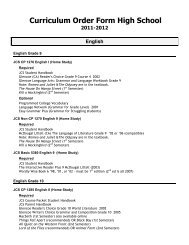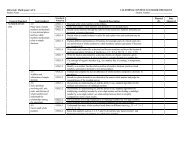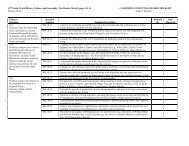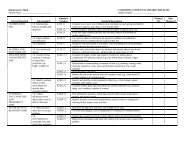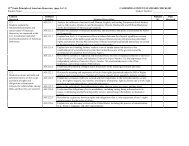2009-2010 Self-Study WASC Action Plan - Julian Charter School
2009-2010 Self-Study WASC Action Plan - Julian Charter School
2009-2010 Self-Study WASC Action Plan - Julian Charter School
You also want an ePaper? Increase the reach of your titles
YUMPU automatically turns print PDFs into web optimized ePapers that Google loves.
Findings<br />
B. CURRICULUM<br />
B1. To what extent do all students participate in a<br />
rigorous, relevant, and coherent standards-based<br />
curriculum that supports the achievement of the<br />
academic standards and the expected schoolwide<br />
learning results? [Through standards-based learning<br />
(i.e., what is taught and how it is taught), the expected<br />
schoolwide learning results are accomplished.]<br />
SUMMARY<br />
• JCS has made a concerted effort to revise all courses of study<br />
in order to make them standards-aligned, rigorous, engaging,<br />
and accessible for all students. Next steps include a more<br />
robust implementation of 21st century skills along with<br />
interdisciplinary themes and literacies (portion of ESLRs).<br />
• Articulating the standards for ourselves and for our parentteachers<br />
and students (“Friendly Standards” in K-8 and<br />
deconstructing the standards in 9-12) allows us to clearly<br />
define our expectations, to set common goals across courses<br />
and departments, and to create a common basis for assessment<br />
and evaluation of student learning and achievement.<br />
RIGOROUS, RESEARCH- BASED ACADEMIC CURRICULUM<br />
• Staff utilizes content area standards and expected<br />
schoolwide learning results (ESLRs) as a framework for<br />
curriculum, projects and other learning outcomes.<br />
• Curricula materials in core subjects (by grade/course)<br />
provide guidance on how to “unpack the standards”<br />
and teach for understanding. Next steps include a<br />
purposeful focus on 21st century skills (ICT Maps).<br />
• Staff is involved in monthly professional learning communities<br />
and bi-monthly forums as well as department<br />
and curriculum meetings to choose curriculum, work<br />
on curricular development, evaluation, and revisions.<br />
• Processes and decisions are regularly reviewed<br />
and/or redesigned to promote deep academic content<br />
knowledge and 21st century skills mastery.<br />
• Assistant directors and/or department chairs and<br />
curriculum leads assist teams in reviewing rigor,<br />
relevancy (power standards), and alignment.<br />
• Safety Net/special education providers use<br />
targeted, research-based curriculum.<br />
Evidence<br />
• Academic standards/CA<br />
Frameworks/ESLRs<br />
• K-8 “Friendly Standards,”<br />
deconstructing standards<br />
work, and curriculum maps<br />
• Standards-based IEP goals<br />
• ICT Literacy Maps<br />
• PLC, forum, site, department<br />
and curriculum team<br />
meeting notes<br />
• STAR exemplars<br />
• Subject area blueprints<br />
• Pre/post examples of<br />
curricular development<br />
• Curriculum adoption cycle<br />
• Curriculum Order Forms<br />
and JCS “Favorites”<br />
• Staff interviews<br />
• SPED population, 9.4%<br />
Chapter 4: <strong>Self</strong>-<strong>Study</strong> Findings: Curriculum<br />
<strong>Julian</strong> <strong>Charter</strong> <strong>School</strong> Focus on Learning <strong>2009</strong>-<strong>2010</strong> 59



